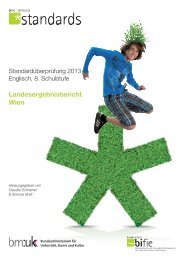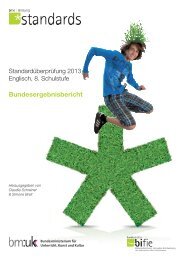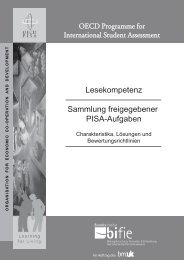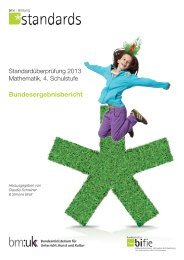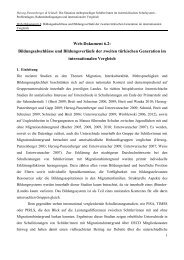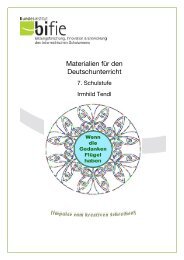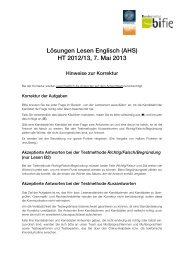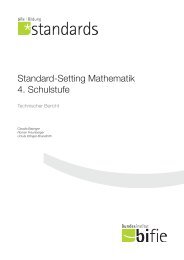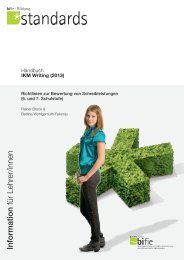Standardisierte kompetenzorientierte Reifeprüfung I Reife - Bifie
Standardisierte kompetenzorientierte Reifeprüfung I Reife - Bifie
Standardisierte kompetenzorientierte Reifeprüfung I Reife - Bifie
Sie wollen auch ein ePaper? Erhöhen Sie die Reichweite Ihrer Titel.
YUMPU macht aus Druck-PDFs automatisch weboptimierte ePaper, die Google liebt.
© Bundesinstitut für Bildungsforschung, Innovation & Entwicklung des österreichischen Schulwesens<br />
B2 Task Achievement*<br />
Assessment Scale B2<br />
• (1) Requirements of set task type fully observed<br />
• (2) Title / subject line / section headings / salutation / closing appropriate<br />
and precise<br />
• (3) All content points addressed and fully developed<br />
• (4) Relevant supporting details / examples are provided for all content points<br />
• (5) Evaluates different ideas / facts / graphs or solutions to a problem<br />
very well TSD**<br />
10 • (6) Explains advantages / disadvantages very well TSD<br />
10<br />
• (7) Gives very good reasons in support of / against points of view TSD<br />
• (8) Successfully and convincingly highlights the personal significance of<br />
events / ideas TSD<br />
• (9) Expresses news and views effectively and relates convincingly to<br />
those of others TSD<br />
• (10) Set word length (+/- 10 %) observed<br />
9 9<br />
• (1) Requirements of set task type almost fully observed<br />
• (2) Title / subject line / section headings / salutation / closing appropriate<br />
• (3) All content points addressed but one or two not fully developed<br />
• (4) Relevant supporting details / examples provided for most content<br />
points (B2.2 R&E) TSD<br />
8<br />
• (5) Evaluates different ideas / facts / graphs or solutions to a problem well<br />
(B2.2 R&E) TSD<br />
8<br />
• (6) Explains advantages / disadvantages well TSD<br />
• (7) Gives good reasons in support of / against points of view TSD<br />
• (8) Successfully highlights the personal significance of events / ideas TSD<br />
• (9) Expresses news and views effectively and relates well to those of others TSD<br />
• (10) Set word length (+/- 10 %) observed<br />
7 7<br />
• (1) Requirements of set task type mainly observed<br />
• (2) Title / subject line / section headings / salutation / closing meaningful<br />
and adequately worded<br />
• (3) Two out of three content points addressed, one of which may not be<br />
fully developed / all content points addressed, but none fully developed<br />
• (4) Relevant supporting details / examples generally provided (B2 TD)<br />
6<br />
• (5) Some attempts to evaluate different ideas / facts / graphs TSD<br />
• (6) Explains advantages / disadvantages adequately (B2.1 R&E) TSD<br />
6<br />
• (7) Gives some reasons in support of / against points of view (B2.1 R&E) TSD<br />
• (8) Highlights the personal significance of events / ideas<br />
(B2 Correspondence) TSD<br />
• (9) Expresses news and views effectively and relates to those of others<br />
(B2 OWI) TSD<br />
• (10) Set word length (+/- 10 %) observed<br />
5 5<br />
4<br />
• (1) Requirements of set task type partially observed<br />
• (2) Title / subject line / section headings / salutation / closing not meaningful /<br />
not adequately worded / partially missing<br />
• (3) Two out of three content points addressed but none fully developed /<br />
sometimes makes up and develops irrelevant content points<br />
• (4) Not enough relevant supporting details provided / supporting details<br />
sometimes irrelevant or include irrelevant information<br />
• (5) Poor attempts to evaluate different ideas / facts / graphs TSD<br />
• (6) Poor attempts to explain advantages / disadvantages TSD<br />
• (7) Gives poor reasons in support of / against points of view TSD<br />
• (8) Fails to highlight the personal significance of events / ideas TSD<br />
• (9) Little / no attempt to express news and views effectively TSD<br />
• (10) Set word length (+/- 10 %) not observed<br />
3 3<br />
4<br />
B2 Organisation and Layout<br />
• (1) Performance has a very clear overall structure at the text level<br />
• (2) Highly effective use of paragraphing<br />
• (3) Develops points in a very clear and systematic way<br />
• (4) Marks relationships between ideas in a very clear way<br />
• (5) Uses a wide variety of linking devices<br />
• (6) Follows standard layout for required task type throughout (visual)<br />
• (1) Performance has a clear overall structure at the text level<br />
• (2) Good use of paragraphing<br />
• (3) Develops points systematically (B2.2 R&E)<br />
• (4) Most relationships between ideas marked<br />
• (5) Uses a variety of linking devices (B2.2 C&C)<br />
• (6) Follows standard layout for required task type throughout (visual)<br />
• (1) Performance has a satisfactory overall structure at the text level<br />
• (2) Generally follows paragraphing conventions (B2 OC)<br />
• (3) Develops points largely systematically<br />
• (4) Some relationships between ideas marked<br />
• (5) Uses a limited number of linking devices (B2.1 C&C)<br />
• (6) Has produced clearly intelligible continuous writing (B2 OC)<br />
• (7) Follows standard layout (B2 OC) for required task type most of the time<br />
(visual)<br />
• (1) Performance has inadequate overall structure at the text level<br />
• (2) Seldom follows paragraphing conventions<br />
• (3) Links only shorter, simple elements into a connected linear sequence<br />
(B1 C&C)<br />
• (4) Only a few relationships between ideas marked<br />
• (5) Only some simple linking devices used<br />
• (6) Has difficulty in producing clearly intelligible continuous writing<br />
• (7) Follows standard layout for required task type only some of the time<br />
(visual)<br />
• (1) Requirements of set task type not observed<br />
• (2) Title / subject line / section headings / salutation / closing not included<br />
• (3) Only one content point addressed / hardly any content points developed<br />
/ frequently makes up and develops irrelevant content points<br />
• (1) Performance has little if any structure at the text level<br />
• (4) Hardly any relevant supporting details provided / supporting details<br />
• (2) Paragraphing conventions largely ignored<br />
mostly irrelevant<br />
• (3) Ideas are presented in a random order without logical connections<br />
2 • <br />
2<br />
(5) No attempts to evaluate different ideas / facts / graphs TSD<br />
• (4) Lack of linking devices<br />
• (6) No attempts to explain advantages / disadvantages TSD<br />
• (5) Lacks clearly intelligible continuous writing<br />
• (7) Gives no reasons in support of / against points of view TSD<br />
• (6) Standard layout largely ignored (visual)<br />
• (8) No attempt to highlight the personal significance of events / ideas TSD<br />
• (9) Unable to express news and views effectively TSD<br />
• (10) Set word length (+/- 10 %) not observed<br />
1 1<br />
• (1) Performance fails to address the task*<br />
0 • (2) Insufficient language for assessment<br />
0 • (1) Performance shows no attempt at organisation<br />
• (3) Communication fails due to illegible handwriting<br />
* If a test taker has written off topic, none of the other criteria will be assessed and a 0 should be awarded.<br />
** TSD = Task specific descriptor means that this descriptor can only be applied to certain task types.



